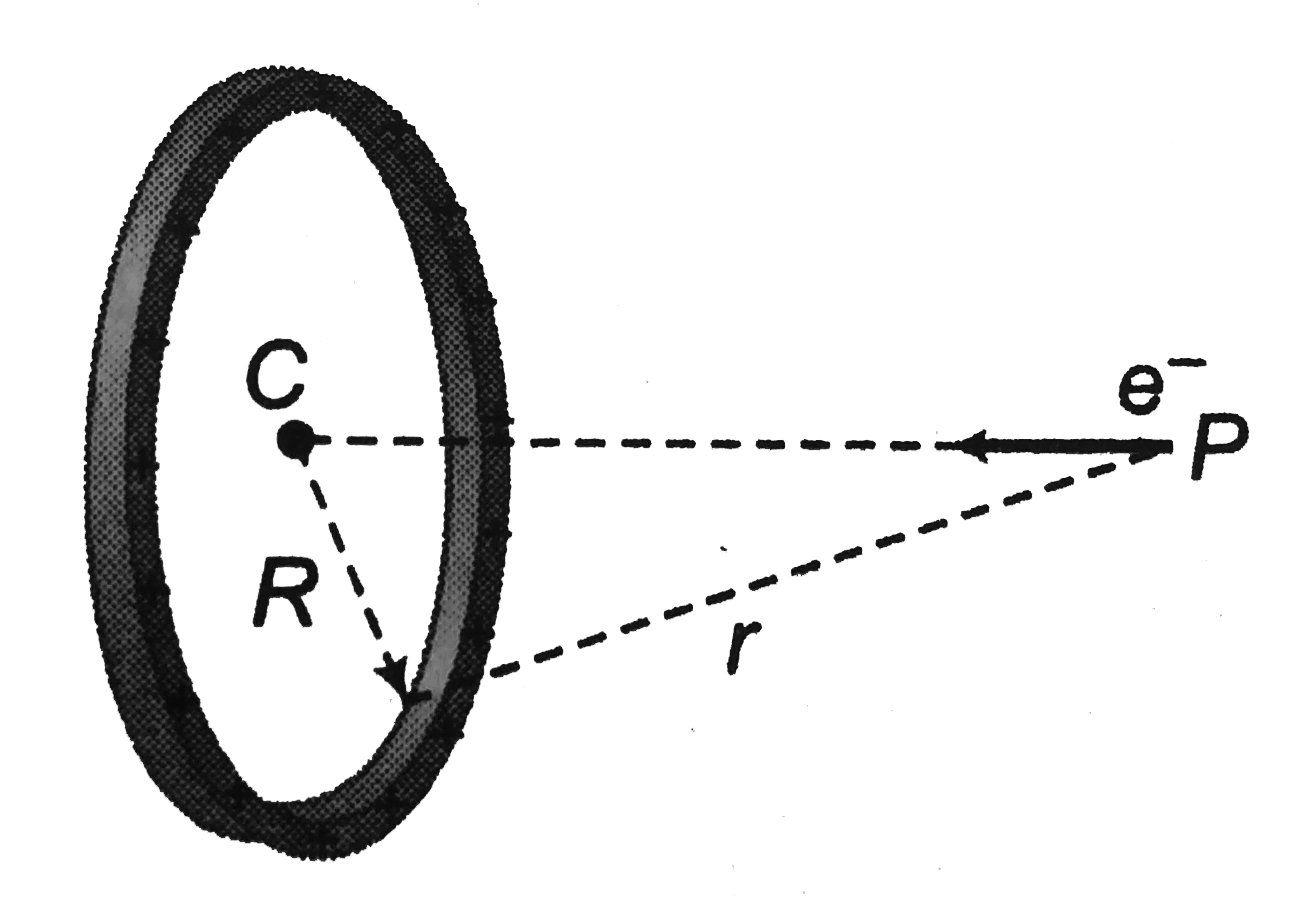A uniformly charged thin ring has radius 10.0cm and total charge +12.0μC. An electron is placed on the ring's axis a distance 25.0cm from the centre of the ring and is constrained to stay on the axis of the ring. The electron is then released from rest.
a. describe the subsequent motion of the electron
b. find the speed of the electron when it reaches the centre of the ring
The correct Answer is:A, D
a. The eletron will be attracted towards the centre of C of the ring. At C net force is zero, but on reaching C electron has some kinetic enegy and due to inertia it crosses C, but on the other side it is further attracted towards C. Hence, motion of electron is oscillatory about point C. 
b. As the electron approaches C,its speed (hence, kinetic energy) increases due to force of attraction towards the centre C. this increase in knetic energy is at the cost of electrostatic potential energy. Thus,
12mv2=Ui−Uf
=Up−Uc=(−e)[VP−VC] .........i
Here, V is the potential due to ring
VP=14πε0.qr (q=charge on ring)
=(9×109)(12×10−9)√(10)2+(25)2×10−2=401V
VC=14πε0.qR
=(9×109)(12×10−9)10×10−2=1080V
Substituting the proper values inn eqn i we have
12×9.1×10−31×v2=(−1.6×10−19)(401−1080)
=v=15.45×106m/s
Topper's Solved these Questions
- BOOK - DC PANDEYCHAPTER - ELECTROSTATICSEXERCISE - Exercise 24.14videos
ELECTROSTATICS
- BOOK - DC PANDEYCHAPTER - ELECTROSTATICSEXERCISE - Exercise 24.29videos
ELECTROSTATICS
- BOOK - DC PANDEYCHAPTER - ELECTROSTATICSEXERCISE - Example Type 83videos
ELECTROSTATICS
- BOOK - DC PANDEYCHAPTER - ELECTROSTATIC POTENTIAL AND CAPACITORSEXERCISE - (C) Chapter exercises50videos
ELECTROSTATIC POTENTIAL AND CAPACITORS
- BOOK - DC PANDEYCHAPTER - GRAVITATIONEXERCISE - All Questions120videos
GRAVITATION
Similar Questions
A uniformly charged thin ring has radius 10.0 cm and total charge +12.0nC. An electron is placed on the ring's axis a distance 25.0cm from the centre of the ring and is constrained to stay on the axis of the ring. The electron is then released from rest, then
(i) describe the subsequent motion of the electron
(ii) find the speed of the electron when it reaches the centre of the ring.View SolutionA ring has radius 30cm and a charge of 2nC .The electric potential on the axis of the ring at a distance of 40cm from its centre will be
View Solution
Knowledge Check
- Question 1 - Select One
An electron released on the axis of a positively charged ring at a large distance from the centre will
ANot moveBDo oscillatory motionCDo SHMDDo non-periodic motion - Question 2 - Select One
An electric dipole is kept on the axis of a uniformly charged ring at distance d from the centre of the ring. The direction of the dipole moment is along the axis. The dipole moment is p, charge of the ring is Q & radius of the ring is R. The force on the dipole is
ApQ3πε0√3R2B4pQ3πε0√3R2CpQ3πε0R2Dzero - Question 3 - Select One
Which statement is true :-
(i) A ring of radius R carries a uniformly distributed charge +Q. A point charge -q is placed on the axis of the ring at a distance 2R from the centre of the ring and released from rest. The particle executes a smiple harmonic motion along the axis of the ring.
(ii) Electrons move from a region of higher potential to that of lower potentialAonly (i)Bonly (ii)C(i), (ii)Dnone of them
Electric charge Q is uniformly distributed around a thin ring of radius a. find the potential a point P on the axis of the ring at a distance x from the centre of the ring .
 View Solution
View SolutionPotential on the axis of ring of radius 3R and at distance 4R from centre of ring is (charge on the ring is Q )
View SolutionA charge Q is uniformly on a ring of radius R. Find the electric potential on the axis of ring at distance x from the centre of the ring. Sketch variation of potential with respect to x.
View SolutionA ring of radius R carries a uniformly distributed charge +Q. A point charge −q is placed on the axis of the ring at a distance 2R from the centre of the ring and released from rest. The particle executes a ismple harmonic motion along the axis of the ring.
View SolutionConsider a uniformly charged ring of radius R and total charge Q. What is the magnitude of maximum possible electric field intensity on the axis of ring? What is the distance of point from the centre of ring at which the electric field is maximum?
View Solution

